Related Research Articles

Hula is a Hawaiian dance form expressing chant (oli) or song (mele). It was developed in the Hawaiian Islands by the Native Hawaiians who settled there. The hula dramatizes or portrays the words of the oli or mele in a visual dance form.
The Maldives is an island nation in the Indian Ocean, and its music is marked mainly by Indian, East African, and Arab influences.
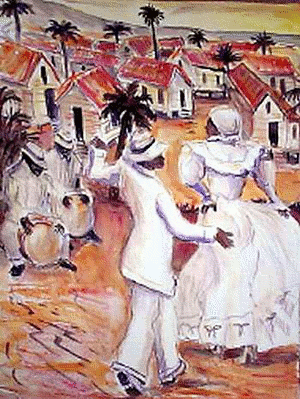
Bomba is an umbrella term that refers to a variety of musical styles and associated dances originating in Puerto Rico. It was developed by enslaved Africans and their descendants in sugar plantations along coastal towns, most notably Loiza, Mayagüez, Ponce, and San Juan, during the 17th century. It is the island's oldest musical tradition.

The traditional music of Tuvalu consists of dances, including fatele, fakanau and fakaseasea. The influence of the Samoan missionaries sent to Tuvalu by the London Missionary Society from the 1860s resulted in the suppression of songs about the traditional religions or magic and many songs were lost. As the influence of the missionaries diminished in the 20th century the traditional dances were revived and the siva dance tradition from Samoa also became popular. The fatele, in its modern form, is performed at community events and to celebrate leaders and other prominent individuals.
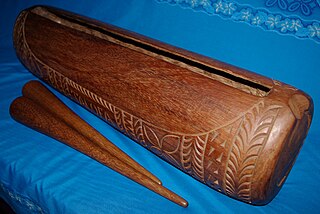
The music of Tokelau occurs in the atolls of Atafu, Nukunonu, and Fakaofo. It is dominated by communal choral activity in harmony, with percussive accompaniment including log drums (pate), pokihi and apa. Nukunonu is notable for traditional song and dance.
Big Drum is a genre, a musical instrument, and traditional African religion from the Windward Islands. It is a kind of Caribbean music, associated mostly closely with the music of Saint Vincent and the Grenadines, Music of Guadeloupe, Carriacou in Grenada and in the music of Saint Kitts and Nevis.

The pahu or paʻu is a traditional musical instrument found in Polynesia: Hawaii, Tahiti, Cook Islands, Samoa, and Tokelau. Carved from a single log and covered on the playing end with a stretched sharkskin, the pahu is played with the palms and fingers of the hand. It is considered a sacred instrument and was generally kept in a temple (heiau), and used to accompany a repertoire of sacred songs called hula pahu/ura paʻu.

The Pātē is a Samoan percussion instrument of Tahitian origin, named after the Samoan word for "beat" or "clap" "pulse". It is one of many Samoan log drum variants and is of the slit drum family, and therefore is also of the idiophone percussion family. It is made from a hollowed-out log, usually of Miro wood and produces a distinctive and loud sound. Different sizes of log drums offer different pitches and volumes, as well as striking the log drum in the middle or near the ends.

The stomp dance is performed by various Eastern Woodland tribes and Native American communities in the United States, including the Muscogee, Yuchi, Cherokee, Chickasaw, Choctaw, Delaware, Miami, Caddo, Tuscarora, Ottawa, Quapaw, Peoria, Shawnee, Seminole, Natchez, and Seneca-Cayuga tribes. Stomp dance communities are active in Georgia, North Carolina, Oklahoma, Alabama, Mississippi, and Florida.
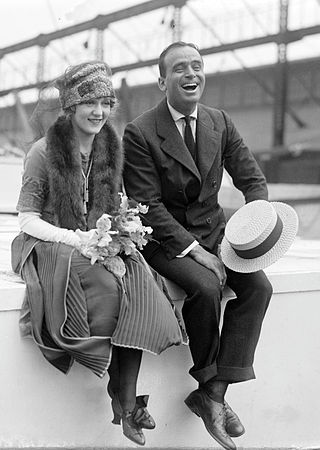
Western fashion in the 1920s underwent a modernization. For women, fashion had continued to change away from the extravagant and restrictive styles of the Victorian and Edwardian periods, and towards looser clothing which revealed more of the arms and legs, that had begun at least a decade prior with the rising of hemlines to the ankle and the movement from the S-bend corset to the columnar silhouette of the 1910s. Men also began to wear less formal daily attire and athletic clothing or 'Sportswear' became a part of mainstream fashion for the first time. The 1920s are characterized by two distinct periods of fashion: in the early part of the decade, change was slower, and there was more reluctance to wear the new, revealing popular styles. From 1925, the public more passionately embraced the styles now typically associated with the Roaring Twenties. These styles continued to characterize fashion until the worldwide depression worsened in 1931.

The xibelani dance is an indigenous dance of the Tsonga women of the Limpopo province in northern South Africa. The name of the dance comes from the native Xitsonga language and it can translate to "hitting to the rhythm", for example, the concept "xi Bela ni vunanga". The name "xibelani" typically refers to the dance style while the skirt itself is referred to as "tinguvu", however, the term "xibelani" is sometimes used to refer to both the dance and the skirt.
The Mapalé is an Afro-Colombian and Ecuadorian style of dance that was brought over by the slaves and representing the fishermen after a long day of work. Its name comes from the Cathorops mapale (fish) when they are out of the water. The dance moves are compared with the agility and strength of those who are performing it. From the clothing to the precise moves of the hips and shoulders. The body movements during the dance are swiftly made to follow the beating of the drums and represent the fish out of the water (men), while the women are the sea.
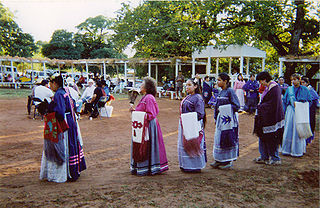
The turkey dance is one of the most important traditional dances among Caddo people. Women dance the turkey dance, while men drum and sing the songs, which describe events in Caddo history.
Several folk dance forms evolved in different regions of Odisha, Odissi and Chhau being some popular forms. Sambalpuri dance is most popular dance of western Odisha and is enjoyed by many.

Solomon Islands dance is part of the culture of the Solomon Islands. Dances are performed at ceremonies and special occasions, as well as on a regular basis in some hotels and restaurants, which feature local musicians performing traditional songs and dance. The National Museum of Solomon Islands at Point Cruz also organises live dances and other cultural displays of its provinces.
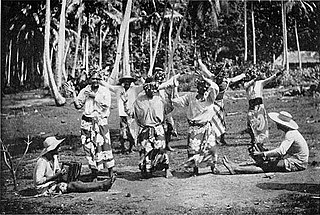
Tahitian drumming is a style of drumming native to Tahiti and French Polynesia. Tahitian drumming and dance have become symbols of Polynesian heiva to the western world. Heiva is the Tahitian term for entertainment. This authentic performance symbolizes the past and present state of social hierarchies within the community and the island. There has been a significant amount of change to Tahitian drum dancing within the past fifty years. These changes have come from many different aspects of Polynesian society. However, many of them stem from the broader outreach of this tradition to the rest of the world. This music has served as inspiration for many other styles across the globe, especially in other areas of the Pacific.

The culture of the Cook Islands reflects the traditions of its fifteen islands as a Polynesian island country, spread over 1,800,000 square kilometres (690,000 sq mi) in the South Pacific Ocean. It is in free association with New Zealand. Its traditions are based on the influences of those who settled the islands over several centuries. Polynesian people from Tahiti settled in the Cook Islands in the 6th century. The Portuguese captain, Pedro Fernandes de Queirós, made the first recorded European landing in the islands in the early 17th century, and well over a hundred years later, in the 18th century, the British navigator, Captain James Cook arrived, giving the islands their current name. Missionaries developed a written language, bringing schools and Christianity to the Cook Islands in the early 19th century. Cook Islands Māori, also known as Māori Kūki 'Āirani or Rarotongan, is the country's official language.

Women in the Cook Islands are women of the Oceanian region who live in or are from the Cook Islands, an island country in the South Pacific Ocean that is in free association with New Zealand.

A basketball uniform is a type of uniform worn by basketball players. Basketball uniforms consist of a jersey that features the number and typically the last name of the player on the back, as well as shorts and athletic shoes. Within teams, players wear uniforms representing the team colors; the home team usually wears a lighter-colored uniform, while the visiting team wears a darker-colored uniform.

Pa'u riders, , are wahine horseback riders who wear long, colorful skirts and characteristically ride astride, rather than sidesaddle. This equestrian tradition's roots are from the early 19th century, when horses were introduced to Hawaii and aliʻi women dressed up to ride for formal occasions. It declined after the overthrow of the Kingdom of Hawaii, but was revitalized in the early 20th century with the establishment of formal riding organizations called Pa'u Riders. Today, they participate in Kamehameha Day floral parades and other parades and festivals throughout the islands.
References
- 1 2 "Dancing & drumming". Enjoycookislands.com. Archived from the original on 10 May 2014. Retrieved 26 March 2014.
- 1 2 3 4 5 Sissons 1999, p. 44.
- ↑ Stanley 1999, p. 312.
- Bibliography
- Sissons, Jeffrey (1 January 1999). Nation and Destination: Creating Cook Islands Identity. editorips@usp.ac.fj. ISBN 978-982-02-0142-2.
- Stanley, David (1999). South Pacific Handbook. David Stanley. ISBN 978-1-56691-172-6.